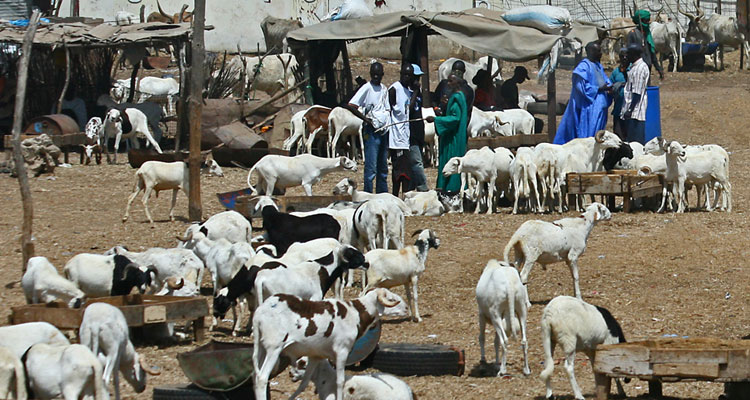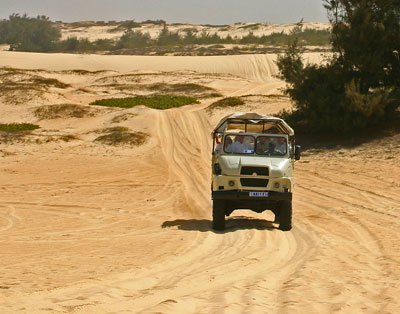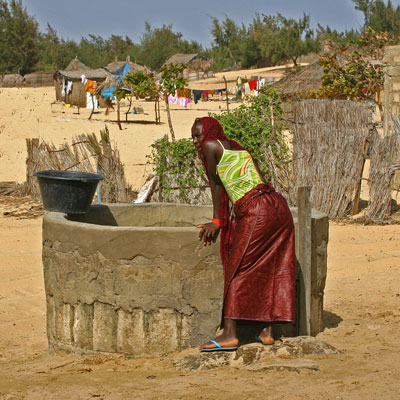Cape Town to the Canaries — cruising the West African coast
by Joyce Bruck, Ocean Ridge, FL
For some time I had been looking for an interesting trip up the west coast of Africa. I finally found one, offered by Silversea Cruises, and, to my excitement, it offered free air travel and a deep discount.
On Feb. 7, 2010, I flew from Miami to Cape Town, South Africa, to begin a three-night pre-cruise adventure before embarking on the 18-night, seven-country cruise, ending in the Canary Islands.
Making plans
I followed my usual strategy that I use before any trip, researching the various ports and what I might expect to see. Typically, I make my own advance arrangements for private sightseeing to supplement the tours offered by the ship. Other times, I wing it on arrival and hire a taxi. (Negotiating the fare and discussing the places you wish to visit prior to getting into the taxi is critical.)
My main concern about private excursions is making sure I am able to return to the ship at the specified time so I will not be stranded.
My research revealed so many interesting options in Cape Town that I had trouble limiting my choices in the three days I had allocated for pre-cruise sightseeing.
Even though I was traveling alone in a place where they drive on the left side, I decided to rent a car from Avis (800/230-4898) for three days (1,127 rand, or $168). With a car, I could take in more at my own speed and stop wherever I wanted.
The arrangements, which I made online, were to pick the car up at the airport and return it to one of the town’s drop-off locations.
Cape Town
After picking up the car and seeing that the sun was making a rare appearance over Table Mountain, I decided to head there. Due to poor directions from Avis, no GPS navigator to help and an inadequate map, I got lost a few times, but my eventual visit was well worth the effort.
For ZAR160 ($21), the cable car took me to the top of Table Mountain, with its desert-like landscape that included interesting plants, reptiles and furry, rodent-like animals called dassies, plus spectacular views.
Unfortunately, my time there was cut short, as I had made reservations for Afternoon Tea at the famous Mount Nelson Hotel (phone +27 [0] 21 483 1948) and for a night’s lodging at Hout Bay, outside of Cape Town.
The terrace view and the elegant Mount Nelson Hotel were interesting, but, for ZAR165 ($21), I found that the spread of sweets, a few small sandwiches, fruit and, of course, tea (or coffee) did not meet my expectations.
After making a few trips to the buffet, I departed. I hoped to see the Kirstenbosch Gardens, but I got lost again. I should have requested GPS for the car. Since it was getting late, I headed toward my hotel in Hout Bay.
In this small fishing village, I stayed overnight at Nenya Guesthouse (phone + 27 [0] 21 790 5361), an attractive bed-and-breakfast about 30 minutes’ drive from Cape Town. The accommodations (ZAR550, or $72, single, or ZAR800, double) were very nice, the breakfast was good and the owner, Lynette Hardy, was very helpful.
Wildlife viewing
Visiting the World of Birds wildlife sanctuary (phone 021 790 2730), only a five- to ten-minute drive from the B&B, was very enjoyable. For the senior rate of ZAR50 ($6.50), I walked through enclosures containing hundreds of species of birds and other small animals.
Then I headed down the peninsula toward the Cape of Good Hope Nature Reserve (entry, ZAR75). (The toll on Chapman’s Peak Drive cost ZAR28.)
There were several driving routes around the reserve. I chose one labeled “Nature Drive,” which led to Olifantsbos Point. I encountered only a couple of cars in the hour I was driving around that section of the park.
I saw baboons, ostriches on the beach, several bontebok (an antelope) and many birds of various species by the water. There was also a footpath one could take, but I didn’t have enough time.
At Cape Point, at the farthest end of the peninsula, visitors can usually take the funicular to the lighthouse, but it was not in operation on the day I was there. For those with enough stamina, there is a hiking trail out to the end. After my brief stop, I proceeded up the coast to my Boulders Beach B&B for the night.
I chose the Boulders Beach Lodge & Restaurant (phone +27 21 786 1758), located in Table Mountain National Park, for my second night in South Africa. Here, I could closely observe one of only three mainland African penguin colonies in the world. (Entrance to this section of the park cost ZAR40.)
I watched in awe as the cute little guys jumped single file over the gulley they had to cross to get to False Bay, where they plunged into the water to float or swim.
I was able to get close to the birds to watch them preparing their nests in sand depressions for the peak breeding season, beginning in February, and wading into the water for their afternoon and morning swims. A couple of them were walking down the narrow boardwalk and almost ran into me. They seemed unafraid of people, but it is not wise to disturb them — especially because of the bites their sharp beaks inflict. This visit was very exciting and one of the highlights of my vacation.
I was not disappointed in the charming Boulders Lodge, which offered excellent cuisine, especially the eggs Benedict for breakfast (included) and a room (ZAR650) that was steps from the beach and the penguins. My delicious dinner of a chicken breast, jasmine rice and brandy pudding came to ZAR128, without the tip.
After Boulders Beach, I made my way up the peninsula through several small, quaint towns, heading for South Africa’s Winelands.
The Winelands
The most popular parts of the wine country that are easily accessible from Cape Town are near the cities of Stellenbosch, Paarl and Franschhoek. How much time one spends in the area is somewhat dependent on whether or not wine tasting is an objective. I left out the wine and went for the scenery, food and other areas of interest to me.
There are 13 designated tour routes to the more than 250 estates and farms there. To make the most of the time allotted, it is best to do extensive research before visiting the Winelands.
My first target was the village of Franschhoek for the noon luncheon reservation I had made at the highly recommended Le Petite Ferme (phone 021 876 3016), part of the vineyard and B&B of the same name. I had the lamb aubergine (ZAR135), which was good, but I was still so stuffed from my eggs Benedict breakfast that I was able to eat only half.
From there I drove to the Spier wine estate in Stellenbosch. Not only can visitors partake in wine tasting there, they can also visit the Cheetah Outreach education center and the Eagle Encounter bird of prey center, a raptor refuge that is also part of the estate.
At Cheetah Outreach (phone 27 [0] 21 881 3242), the cheetahs can be observed, photographed and even petted (with supervision). They can be seen daily from 10 a.m. to 5 p.m., mainly on a first-come, first-served basis, so no reservations are required to visit. Entry costs ZAR10 plus ZAR80 per adult (40 per child) to pet them.
The raptor sanctuary, located a few feet away, charges a similar amount for entry. I found this attraction to be much more interesting. Among the birds and animals that have a home there are a crowned eagle, a secretary bird, a yellow-billed kite, a peregrine falcon and an African tortoise. Many of them are cuffed to a perch but not caged.
While I was there, they received four new birds to be admitted for various reasons. For example, a huge crowned eagle with powerful talons had been killing cattle, so it was sent to the sanctuary rather than killed. I watched the fascinating process as the bird was uncrated, secured and calmed from its excited state. Holding the animal took three men. It was quite a sight.
My last stop for the day was a Cape Dutch farm/vineyard and estate called Boschendal (phone +27 [0] 21 870 4272) on the scenic Pniel Road. I toured the interesting manor house, constructed in 1812. Wine tasting was available, and a restaurant, gift shop, dairy and café were on the grounds.
On my last night in Cape Town, I stayed near the highly recommended Victoria & Alfred Waterfront section at the five-star Commodore Hotel on Portswood Road. My room ($215) was lovely, the included breakfast was superb and the personnel were extremely helpful.
This reservation was made for me by Cheryl Gould of Lion World Tours (Toronto, Ontario; 800/387-2706 in the US, 800/668-9968 in Canada); she also handles tours in Africa.
While having a car during my pre-cruise stay was a good idea, driving was very difficult, especially since I was alone and had no one to navigate; they drove on the “wrong side”; maps were poor, and, in the city, there were lots of twists and turns in fast-moving traffic.
I managed, but by the time I returned to the hotel I was tired of struggling, so I requested that Avis pick up the car at my hotel. For this service they charged me an extra $27, a cheap price to keep me alive and in one piece!
Robben Island
I had one morning left in Cape Town before my afternoon cruise departure. I chose to visit Robben Island, an apartheid prison. My interesting 3½-hour outing (ZAR200) left from the Clock Tower terminal on Quay 5, close to Jetty 1. Since the trips are frequently full, it is advisable to make your reservation in advance online and arrive at least 30 minutes prior to departure.
A boat took the group to the island, where we were met with buses and an escort, a former inmate, who gave us the history of the area and background on its prisoners. The tour led us through the prison buildings, including cells of South African freedom fighters such as Nelson Mandela and Robert Sobukwe. I’d recommend bringing a hat, sunscreen and sunglasses.
Cape Town is such an interesting travel destination. I could have spent a lot more time seeing attractions in the city and its environs, but now I have a reason to return.
On to the ship
On Feb. 12 I boarded the Silver Wind, a six-star, 296-passenger, all-suite ship. We spent a day at sea before reaching our first port, Walvis Bay, Namibia. I was looking forward to this port since enjoying it so much on an August ’07 visit to Namibia (Nov. ’07, pg. 6).
The first time, I took a fabulous one-day 4x4 tour to Sandwich Harbour with a local tour company. This time I used Atlantic Aviation (phone +264 [0] 64 404749) to go “flightseeing” over the Skeleton Coast to see wrecked ships buried in the sand, beautiful red sand dunes and, hopefully, some animals. Unfortunately, we saw only one zebra, which appeared as a speck below us.
I thought that the cost of 3,050 Namibian dollars ($453) per passenger for the 2½-hour crossing of 360 miles was not worth it compared with my Sandwich Harbour day outing, which cost less. However, the full-day flight or an overnight trip might be better because it goes north, close to the Angola border, where more animals are roaming and native people live.
In the evening we were treated to a “desert experience,” which consisted of a trip into the dunes in 4x4 vehicles to a setting that seemed like a mirage. Large tents arose from the skyline, and we were met by local musicians and Herero women, the latter in their native costumes of billowing dresses and hats each topped with a large bow.
Camels were available for those who wanted to give traversing the dunes a try. Others walked up the high mountains of sand.
A buffet with typical foods was served, and local singers and dancers entertained us.
São Tomé
After three days at sea we arrived at our second port, São Tomé, the capital of São Tomé & Príncipe, where I took the ship’s tour “The Birds of São Tomé” ($59). Some of the other passengers went on a visit to the São João Cocoa Plantation ($139) or Claudio Corallo’s Chocolate Factory ($49) or took the city tour ($89).
Since my selected excursion passed through several villages, I was treated to captivating glimpses of native life as people washed clothes at wells, sold fruits and vegetables on corners and fixed cars in the street.
After disembarking from the van, our group began an easy walk to a nice waterfall, attempting to spot the small birds that were so well hidden in the forest that only quick glimpses were possible. Attractive coffee plants, flowers and other vegetation lined the pathway.
After São Tomé, we spent four days at sea on our way to Banjul, The Gambia. This capital city, founded by the British early in the 19th century, has become the center of commerce for the area. My chosen excursion ($109) was to the Makasutua Culture Forest, a 1,000-acre private reserve located within a palm forest.
The tour was designed to show passengers some of the native birds, such as kingfishers and herons, as we floated in our pirogue along a small river called Mandina Bolong. In one interesting spot, local boys tossed nets out into the water to catch the oysters growing among the mangroves.
Following the boat trip, we had a traditional Gambian buffet lunch, then took a walk with a guide, who identified plants and explained their medicinal value. The grounds contained a craft area and a small museum. We were told we might see monkeys and deer, but we saw none.
Although the pirogue excursion was interesting, I was a little disappointed in the rest of the tour. Perhaps I expected too much.
A memorable day
The capital city of Dakar, Senegal, was my favorite port of call and one of the highlights of my trip. Here I took a tour called “Pink Lake Retba” ($109). The excitement began as soon as we boarded the large bus for the 25-mile drive into the Sahara. The traffic, including horse-drawn carts, was horrendous. In order to ensure that we got there and back, the city provided us with two motorcycle police escorts to, as best they could, clear the way for us.
Along the way, we drove through villages, passing cattle markets, women carrying all sorts of goods on their heads, stalls selling or fixing various items, and Internet cafés.
After an hour or so we reached a small resort with colorful villas situated between the lake and the hotel pool. After a much-needed rest and a cool drink, we transferred to large four-wheel-drive trucks, each accommodating about 12 people. Then the fun/scary part of the day began.
We drove past the red lake to observe people in shallow boats harvesting salt. I wanted so much to get out to snap some photos, but we went on.
The next area compensated for what I had missed. We stopped at a village called Niaga, where people were engaged in their daily activities. The best part was that we could shoot whatever photos we liked without paying to take pictures. The villages asked only that we look at the crafts they had for sale.
We reboarded the trucks for an exciting roller-coaster ride up, down and around the huge white sand dunes. On the other side was a surprise: the ocean, with small waves washing up on a gorgeous beach. Tall, thin palm trees lined the horizon.
We drove single file along the packed sand to return to the resort. I hated to leave. It was a day that I will long remember.
Independent touring
After making a list of sites I wanted to visit in the Mindelo area of Cape Verde’s São Vicente island, I decided to hire a taxi for two hours ($25 plus $5 tip) to take me around. As with the driver I had hired at an earlier stop in this island nation, this one did not speak much English, but he knew where to go.
We covered a lot of the city in a short period of time, including the colorful Municipal Market; the Torre de Belém, a replica of the famous Lisbon landmark; the fish market; the Town Hall; the Presidential Palace, and the Cultural Center. We also stopped at the interesting Praça Estrela (Star Square), filled with clothing stalls. My tour was terrific, both for taking photos and observing people.
One thing I really enjoyed was the pretty church called Praçinha da Igreja, located in the oldest part of town. Our arrival coincided perfectly with a baptismal ceremony. All of the families were in their “Sunday best,” and the honored female children were in beautiful white dresses.
Unfortunately, the ship had no sightseeing tour at our last port, Las Palmas in the Canary Islands, so I rented a car again for the day, this time from a local company called Cicar (phone 928 822 900), at a price of €37 ($45.50) including insurance. Once again, I got lost a few times.
The agency’s pickup point was the cruise ship harbor. How complex could that be? It took me about 30 minutes and several conversations with the cooperative harbor police to find out that the car was in a building right next to where our ship was docked.
After establishing that, getting the car was easy. However, I could not follow the sketchy driving directions to my hotel for the night, given in broken English, or the map I was given that did not consider the many one-way streets.
As so much time had passed since my departure from the ship, I figured I had better go to the hotel to let them know I was in town before taking off for the rest of the day. This was easier said than done.
I eventually found the four-star Santa Catalina Hotel ($159 booked through Expedia.com) about three miles from the port, but tour buses were blocking the driveway and there was no parking area for reception. I thought I could just run in and leave a message, but one large tour group was checking out as a transit group from my ship was trying to register. Big mess!
Having lost about two hours of my one day on the island, I had to shelve my original touring plans. There just wasn’t enough time left.
Gran Canaria
I decided to head, instead, toward some small villages and local sites recommended in my guidebooks.
From the causeway bordering the bay, I noticed the historic Old Town quarter, Barrio Vegueta, with the large spires of the Cathedral of Santa Ana. However, my attempts at getting a parking space proved to be unfruitful, so I decided to return later.
I went farther along the highway to locate Las Palmas’ often-photographed city suburb with colorful buildings built into the hillside. After snapping a few photos, I headed toward the beach.
It was spectacular though a little scary driving the road that curved through the Barranco de Guayadeque, deep canyons lined by ridges and mountains with almond, palm and cactus trees.
In the quaint city of Agüimes (phone 928 124183 for info), I stumbled upon the central park, then wandered through the cobblestone streets and alleyways to the Templo de San Sebastián. There were interesting restaurants and inviting B&Bs in this area — perfect for an overnight stop — but time was a luxury I did not have, as I was heading home the next day.
The newer city of Maspalomas is a big attraction for European vacationers. There was a sweeping, six-kilometer beach with huge waves crashing on the rocks, plus sand dunes and a lighthouse close by. Coming from Florida, I found it to be cold and forbidding, but lots of people seemed to be enjoying themselves. Hotels, condos, stylish stores and several places to eat with water views dotted the area.
I returned to the Old Town before dropping off my rental car. This time I found public parking, for a fee, in Vegueta. I took the short walk to see the Cathedral, the Casa de Colón Museum and the Colón Theatre.
The details
For this cruise, proof of a yellow fever vaccination is required within the last 10 years. People over 65 years of age, especially those who have never had the vaccination, may be advised not to take the shot. In that case, a special letter is required from the doctor. Check further with the CDC, the ship and your doctor.
My 18-night cruise with Silversea Cruises (Ft. Lauderdale, FL; 877/276-6816) cost $10,224, including $732 for travel insurance and a large single supplement.
I used a cruise consultant to book. Arthur Balin of The Cruise Web (800/377-9383, ext. 311) was very helpful on this and other cruises I have taken.
The itinerary during my three days in Cape Town was planned using several guidebooks, such as Fodor’s, Frommer’s and DK Eyewitness. I arranged for all hotels and car rentals on the Internet.

